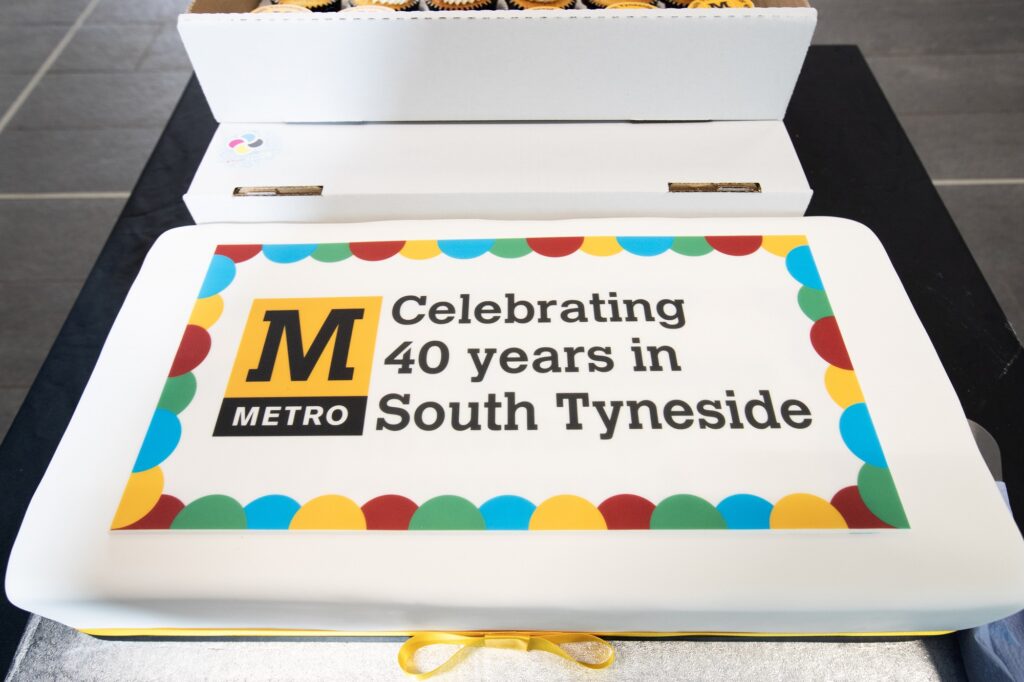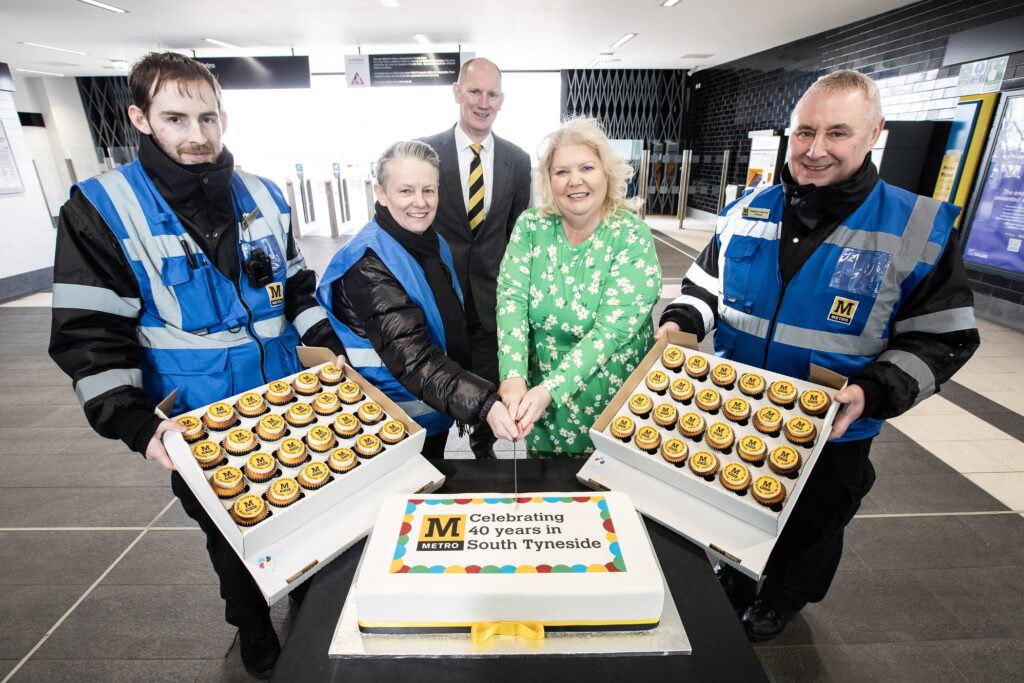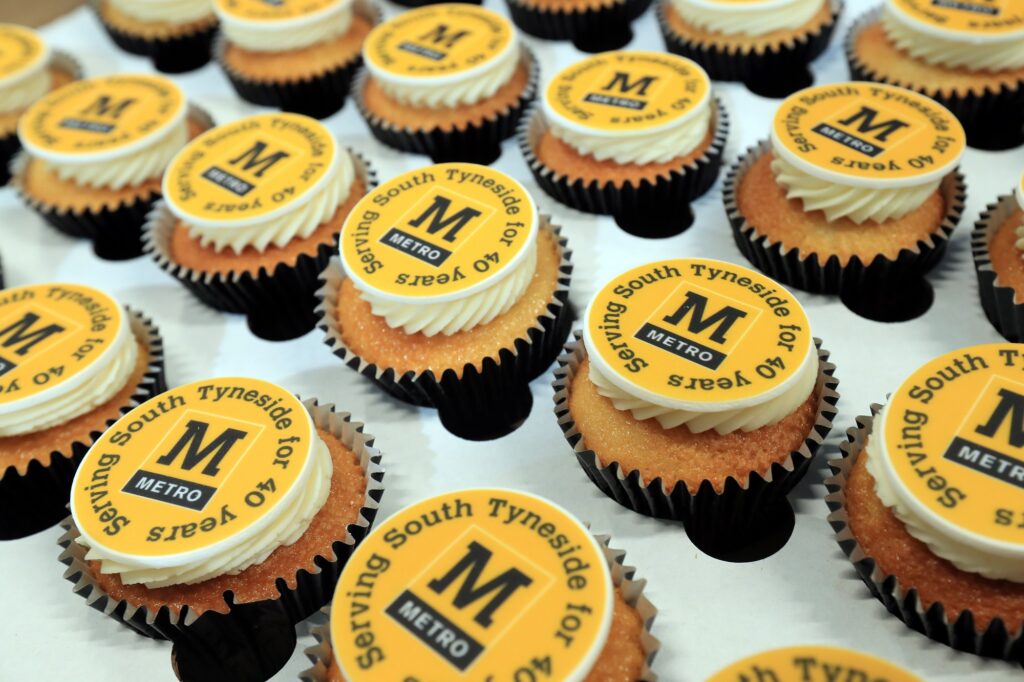Metro line in South Tyneside celebrates its 40th anniversary
The Tyne and Wear Metro line through South Tyneside is celebrating its 40th anniversary.
The line has carried 200 million Metro customers since it opened in March 1984, helping people get to work, education and leisure activities.
Nexus, the public body which operates Metro, said the route from Heworth to South Shields was a key part of Metro’s story, one that has transformed connectivity in the borough.
Nexus has marked this latest Metro landmark with a special birthday cake cutting ceremony at South Shields Interchange – which included handing out free cupcakes for Metro customers.

Cllr Audrey Huntley, Deputy Leader of South Tyneside Council, said: “The Metro is an integral part of everyday life for so many people in the borough and beyond, connecting them to jobs, study and leisure amenities, not to mention helping to showcase our tourism offer to millions of visitors.
“Sustainable travel is key if we are to achieve our carbon neutral goals, so as we collectively work towards a low carbon future the Metro will remain part of the fabric of our communities for decades to come.”
Cathy Massarella, the Managing Director of Nexus, said: “We’re delighted to be celebrating the 40th anniversary of our Metro line in South Tyneside. It’s been transformative for the borough over the last four decades.
“We’ve seen an amazing 200 million journeys on the line since it opened in 1984. It’s part of everyday life for the people of South Tyneside, has boosted the local economy, and has helped to underpin the success of the Great North Run, which finishes in South Shields.
“It was a fantastic achievement to bring the Metro to South Tyneside and we are already looking ahead to an exciting future as we get ready to welcome the first Metro trains in customer service this year.”
“When the Metro system first opened in 1980 the plans were already in place to extend the route beyond Heworth, widening the network’s connectivity, which in turn has helped to cut congestion on local roads.”
Alan Metcalfe, Chair of South Tyneside Chamber of Commerce, said: “Metro has been vital for businesses in South Tyneside over the last 40 years, opening up access to more talent over the region, particularly from Newcastle and Sunderland.
“The final piece in the jigsaw was the recent completion of the £100m Metro Flow project to dual three key sections of the line, which is vital for the economy and infrastructure of the borough. It is vital for our carbon footprint that we have more passengers travelling by a regular, economical and reliable service.
“I would like to congratulate Nexus on this significant milestone, and here’s to the next 40 years.”


The Metro line into South Tyneside was the final piece of the Metro construction project, which saw the system opened in phases from August 1980.
Formerly part the old Tyneside Electric Network the line was taken over by Nexus and was converted to fit Metro trains, with a mix of new stations and some old ones transformed into Metro stations.
The first train with customers on board ran through from Heworth to South Shields in March 1984. Civic dignitaries attended a ribbon cutting event at South Shields Metro station to mark the opening.
The line had a further Metro station added at Simonside in 2008, and South Shields Metro station on King Street closed in 2019 to make way for the town’s new transport interchange.
Nexus brought Metro to Gateshead in 1981, to South Shields in 1984, to Newcastle Airport in 1991, and to Sunderland in 2002.
About the South Tyneside Metro line:
The Metro line in South Tyneside runs from Pelaw to South Shields and was opened on 23 March 1984.
It is 11.8km in length.
There are seven Metro stations in South Tyneside – Hebburn, Jarrow, Bede, Simonside, Tyne Dock, Chichester, South Shields.
It was formerly part of the old Tyneside Electric rail network which the Tyne and Wear PTE took over from British Rail and converted to allow it to carry Metro services.
Hebburn Metro station: Opened on 1 March 1872 by the North Eastern Railway. The station became a Tyneside Electrics station around 1938 and was de-electrified in 1963. Following closure for conversion to Metro in the early 1980s, the station was demolished and re-built, with staggered platforms on each side of the bridge on Station Road.
Jarrow Metro station: Jarrow is most famous for its iconic station artwork depicting the 1936 Jarrow Crusade. Vince Rae’s sculpture, Jarrow March, which was unveiled by Labour Party Leader Neil Kinnock in 1984, was adapted from contemporary photograph of the marchers with their banner. It was made using steel from a scrapped ship.
Bede Metro station: Named after the English monk, the Venerable Bede is widely regarded as the ‘father of English history’, Bede was an author, scholar, linguist and translator who also composed works on astronomical timekeeping and the motions of the sun, Earth and Moon. His most famous work is The Ecclesiastical History of the English People. One of the most important original references on Anglo-Saxon history, this work also played a key role in the development of an English national identity.
Bede Metro station is also noted for being the Metro stop to alight at to get to the world famous Barbour factory.
Simonside Metro station: Simonside remains the newest station on the Tyne and Wear Metro. It became the network’s 60th station when it opened to customers in 2008.
Tyne Dock Metro station: Opened as Jarrow Dock on 1 August 1856, by the Stanhope and Tyne Railway. It was later resited and renamed Tyne Dock on 1 January 1861. The resited station was situated to the east of the divergence of the Brandling Junction Railway and the Stanhope and Tyne Railway route via Chichester. The current Metro station is built to the east of the divergence, but on the former Stanhope and Tyne Railway route.
Chichester Metro station: There is a tunnel at Chichester which was a former goods line through to Westoe Colliery. The line itself was also the spot of the Westoe Netty, an open air public urinal which was depicted in a famous 1972 painting by Bob Olley. These toilets were saved when the colliery line was demolished, and are now preserved at the Beamish Open Air Museum in County Durham. In regards to the station, the colliery line ran behind Platform 2 with the tunnel beneath the concourse still visible from the Dean Road bridge.
The statue of Queen Victoria which stands at the front of South Shields Town Hall was moved to Chichester in 1949 and it stayed there until 1981m when it was moved back to make room for the Metro station.
South Shields: Now served by a completely new bus and Metro interchange which opened in the summer of 2019. The first South Shields Metro station was on nearby King Street. The station, which was originally located on Mile End Road, was opened on 2 June 1879 by the North Eastern Railway; it later became a part of the Tyneside Electrics railway network. It closed in June 1981, for conversion to part of the Tyne and Wear Metro system. The new South Shields Interchange is now home to a permanent cast of Sir Mo Farah’s footprints to mark his six wins at the Great North Run.
Conversion work saw the station relocated about 200m up the line from the former British Rail station, with the construction of a new facility on a bridge over King Street. The original Grade II listed station building, located near to Mile End Road, remained following conversion but was demolished in the late 1990s after falling into disrepair.
Fun facts:
When the South Tyneside Metro line first opened the singer and songwriter Lionel Richie was at the top of the UK singles charts with Hello. The biggest grossing films in cinemas were Risky Business, Terms of Endearment and Scarface.
Metro 40 years: timeline:
1971: Studies reveal light rail is a solution to take pressure off Tyneside’s congested road network
1972: Government agrees to fund the Tyne and Wear Metro project at a cost of £100m
1974: Construction begins
1980: Metro system opens to passengers – Haymarket to Tynemouth
1981: The Queen officially opens the Tyne and Wear Metro as the line to Gateshead opens.
1984: South Tyneside line opens
1991: Metro extension to Newcastle Airport is opened
2002: The Queen opens the Sunderland line
2009: Government agrees to fund £350m Metro modernisation programme
2014: Metro train fleet refurbishments completed.
2020: Nexus orders a new fleet of trains to arrive by 2023

Radio Shields was LIVE from the event.
Presenter Risaria who hosts a weekly Fun Fare with Ferry Tales featuring tales of the Ferry was live o-air from the event and she spoke to Huw Lewis who is the Customer Service Director for Nexus and Cllr Audrey Huntly who is the Deputy leader of South Tyneside Council.

